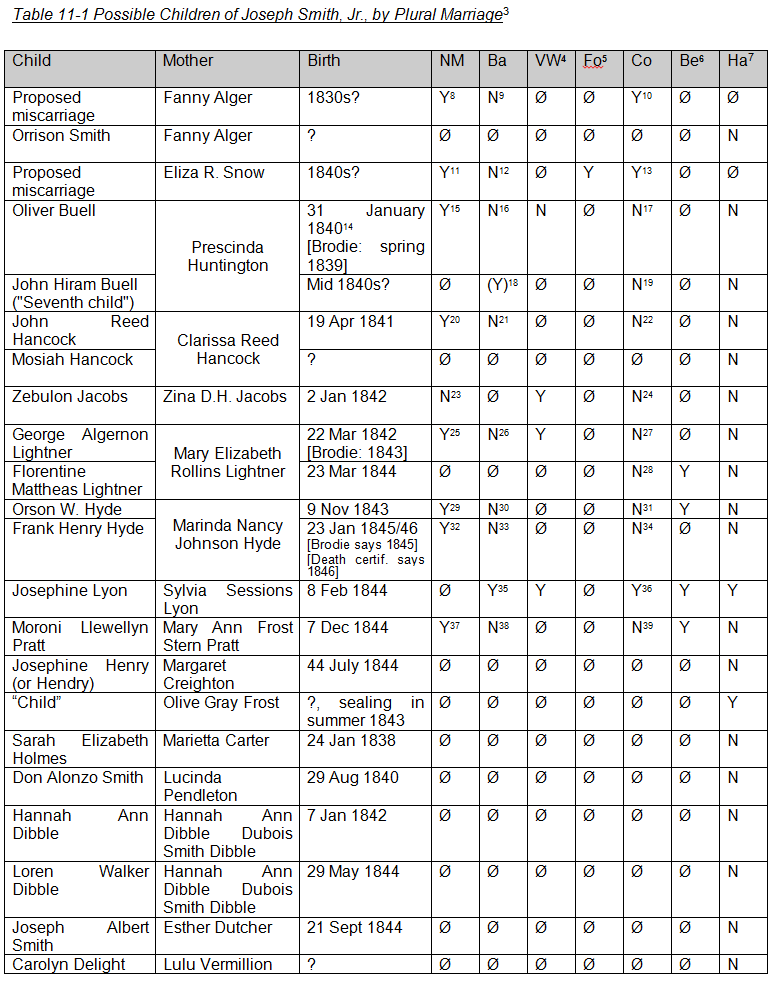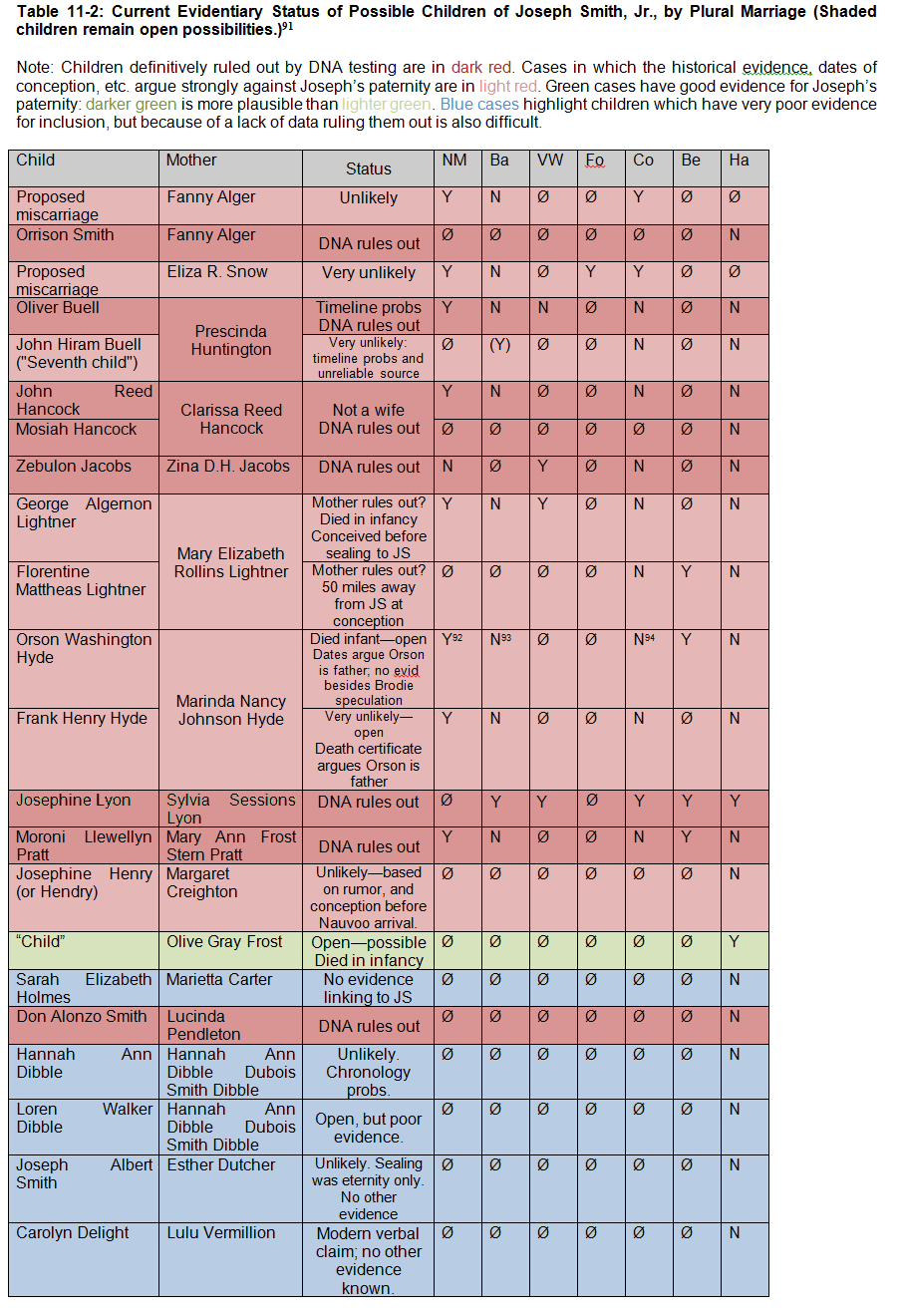- REDIRECTTemplate:Test3
Question: What do we know about whether or not Joseph Smith fathered any children by his plural wives?
While the record is frustratingly incomplete regarding sexuality, it does little but tease us when we consider whether Joseph fathered children by his plural wives
While the record is frustratingly incomplete regarding sexuality, it does little but tease us when we consider whether Joseph fathered children by his plural wives. Fawn Brodie was the first to consider this question in any detail, though her standard of evidence was depressingly low. Subsequent authors have returned to the problem, though unanimity has been elusive (see Table 1). Ironically, Brodie did not even mention the case of Josephine Lyon, now considered the most likely potential child of Joseph.
Table 1
Table 11‑1 Possible Children of Joseph Smith, Jr., by Plural Marriage[1]

Endnote links for above table
[2]
[3]
[4]
[5]
[6]
[7]
[8]
[9]
[10]
[11]
[12]
[13]
[14]
[15]
[16]
[17]
[18]
[19]
[20]
[21]
[22]
[23]
[24]
[25]
[26]
[27]
[28]
[29]
[30]
[31]
[32]
[33]
[34]
[35]
[36]
[37]
- REDIRECT Question: Did Joseph Smith produce any children by his plural wives? The case for children
- REDIRECTJoseph_Smith_and_children_through_plural_marriage#Did_Joseph_Smith_produce_any_children_by_his_plural_wives.3F_The_case_against_children
Current State of the Evidence
Few authors agree on which children should even be considered as Joseph's potential children. Candidates which some find overwhelmingly likely are dismissed—or even left unmentioned—by others. Recent scholars have included between one to four potential children as options. Of these, Josephine Lyon is the most persuasive, and is amenable in theory to DNA testing. Orson W. Hyde died in infancy, and so can never be definitively excluded as a possible child, though the dates of conception argue against Joseph's paternity. Oliver Gray Frost is mentioned in two sources as having a child by Joseph. Both she and the child died in Nauvoo, so no genetic evidence will ever be forthcoming.[38]
Table 2
This table is in the same order as Table 1.[39]

Endnote links for above table
Brodie;[40] Bachman;[41]; and Compton.[42]
As always, we are left where we began—with more suspicions and possibilities than certitudes. One's attitude toward Joseph and the Saints will influence, more than anything else, how these conflicting data are interpreted.
The uncertainty surrounding Joseph's offspring is even more astonishing when we appreciate how much such a child would have been valued. The Utah Church of the 19th century was anxious to prove that Joseph had practiced full plural marriage, and that their plural families merely continued what he started. Any child of Joseph's would have been treasured, and the family honoured. There was a firm expectation that even Joseph's sons by Emma would have an exalted place in the LDS hierarchy if they were to repent and return to the Church.[43] As Alma Allred noted, "Susa Young Gates indicated that [Brigham Young] wasn’t aware of such a child when she wrote that her father and the other apostles were especially grieved that Joseph did not have any issue in the Church."[44]
In 1884, George Q. Cannon bemoaned this lack of Joseph's posterity:
There may be faithful men who will have unfaithful sons, who may not be as faithful as they might be; but faithful posterity will come, just as I believe it will be the case with the Prophet Joseph's seed. To-day he has not a soul descended from him personally, in this Church. There is not a man bearing the Holy Priesthood, to stand before our God in the Church that Joseph was the means in the hands of God, of founding—not a man to-day of his own blood,—that is, by descent,—to stand before the Lord, and represent him among these Latter-day Saints.[45]
Brigham and Cannon, a member of the First Presidency, would have known of Joseph's offspring if any of the LDS leadership did. Yet, despite the religious and public relations value which such a child would have provided, they knew of none. It is possible that Joseph had children by his plural wives, but by no means certain. The data are surprisingly ephemeral.
Notes
- ↑ MN = Brodie, No Man Knows My History, 2nd edition (1971); Bachman, "Mormon Practice of Polygamy" (1975); VW=Van Wagoner, Mormon Polygamy, 2nd edition (1989); Fo = Foster, Religion and Sexuality (1984); Co = Compton, In Sacred Loneliness (1997); Be = Bergera, "Identifying the Earliest Mormon Polygamists," (2005); Ha = Hales, Joseph Smith’s Polygamy (2013).Y – indicates the author considers the child a possible child of Joseph Smith, Jr. N - indicates that author argues against this child being Joseph's child, or lists someone else as the father. Ø - indicates that author does not mention the possibility (pro or con) of this being Joseph's child.
- ↑ Richard S. Van Wagoner, Mormon Polygamy: A History (Salt Lake City: Signature Books, 1989), 43–44, and 43n43.
- ↑ Lawrence Foster, Religion and Sexuality: The Shakers, the Mormons, and the Oneida Community, Illini Book Edition ed. (New York: Oxford University Press, 1984 [1981]), 157–158.. Foster notes that "there are a number of family traditions in Utah of children by plural wives of Joseph Smith, I have not been able to investigate them closely enough to determine their possible validity" (311n116). Foster then cites Brodie for examples of such allegations. Foster's work cannot be considered an independent examination of the evidence for or against the paternity of specific individuals.
- ↑ Bergera writes that four "may or may not" have been fathered by Joseph, citing Todd Compton, "Fawn Brodie on Joseph Smith's Plural Wives and Polygamy: A Critical View," in Reconsidering No Man Knows My History: Fawn M. Brodie and Joseph Smith in Retrospect, ed. Newell G. Bringhurst (Logan, Utah: Utah State University Press, 1996), xxx. as the authority. See Gary James Bergera, "Identifying the Earliest Mormon Polygamists, 1841–44," Dialogue: A Journal of Mormon Thought 38/ 3 (Fall 2005): 49–50n115. Interestingly, Compton's article lists only one of these four (Josephine Fisher) as a likely child of Joseph's—Bergera's reference does not support his claim.
- ↑ Hales, Joseph Smith's Polygamy Vol. 1, 298–299.
- ↑ Fawn M. Brodie, No Man Knows My History: The Life of Joseph Smith (New York: Alfred A. Knopf, 1945), 345. ( Index of claims )
- ↑ Danel W. Bachman, “A Study of the Mormon Practice of Polygamy Before the Death of Joseph Smith,” (1975) (unpublished M.A. thesis, Purdue University), 140.
- ↑ Compton, "Fawn Brodie on Joseph Smith's Plural Wives," 172.
- ↑ Brodie, No Man Knows My History, 301–302, 345–346, 470–471.
- ↑ Bachman, "Mormon Practice of Polygamy," 140.
- ↑ Compton, "Fawn Brodie on Joseph Smith's Plural Wives," 172.
- ↑ Compton, "Fawn Brodie on Joseph Smith's Plural Wives," 167–168. gives the following data which argue for the 1840 birthdate: Prescinda's genealogy records, Essom's Pioneers and Prominent Men of Utah, "A Venerable Woman," Women's Exponent, Prescinda's holographic autobiography. Only Augusta Joyce Crocheron, Representative Women of Deseret mentions the 1839 date, saying merely, "About this time' her son Oliver was born" (italics added). Clearly the 1840 date has much better attestation.
- ↑ Brodie, No Man Knows My History, 301–302, 345, 460–462. Brodie was so convinced of Joseph's paternity, that she wrote "If Oliver Buell isn't a Smith them I'm no Brimhall [her mother's family]." - Fawn Brodie to Dale Morgan, Letter, 24 March 1945, Dale Morgan papers, Marriott Library, University of Utah; cited by Compton, "Fawn Brodie on Joseph Smith's Plural Wives," 166. Compton devastates Brodie's circumstantial case for Buell as a child of Joseph (166–173), and DNA has definitively vindicated his skepticism.
- ↑ Bachman, "Mormon Practice of Polygamy," 137–138.
- ↑ Compton, "Fawn Brodie on Joseph Smith's Plural Wives," 166–173.
- ↑ Bachman, "Mormon Practice of Polygamy," 139. suggests that this child is more likely than Oliver to be Joseph's, but he remains skeptical.
- ↑ Compton, "Fawn Brodie on Joseph Smith's Plural Wives," 167.
- ↑ Brodie, No Man Knows My History, 345, 464.
- ↑ Bachman, "Mormon Practice of Polygamy," 139.
- ↑ Compton, "Fawn Brodie on Joseph Smith's Plural Wives," 164.
- ↑ Brodie, No Man Knows My History, 465.
- ↑ Compton, "Fawn Brodie on Joseph Smith's Plural Wives," 164.
- ↑ Brodie, No Man Knows My History, 345, 467.
- ↑ Bachman, "Mormon Practice of Polygamy", 140}}
- ↑ Compton, "Fawn Brodie on Joseph Smith's Plural Wives," 165.
- ↑ Compton, "Fawn Brodie on Joseph Smith's Plural Wives," 165.
- ↑ Brodie, No Man Knows My History, 345, 464.
- ↑ Bachman, "Mormon Practice of Polygamy," 139.
- ↑ Compton points out that "It is striking that Marinda had no children while Orson was on his mission to Jerusalem [15 April 1840–7 December 1842], then became pregnant soon after Orson returned home. (He arrived in Nauvoo on December 7, 1842, and Marinda bore Orson Washington Hyde on November 9, 1843). – Compton, "Fawn Brodie on Joseph Smith's Plural Wives," 165.
- ↑ Brodie, No Man Knows My History, 345, 464.
- ↑ Bachman, "Mormon Practice of Polygamy," 139–140.
- ↑ Compton, "Fawn Brodie on Joseph Smith's Plural Wives," 165.
- ↑ Bachman, "Mormon Practice of Polygamy," 140–141.
- ↑ Compton, "Fawn Brodie on Joseph Smith's Plural Wives," 172.
- ↑ Brodie, No Man Knows My History, 345, 464.
- ↑ Bachman, "Mormon Practice of Polygamy," 139–140.
- ↑ Compton, "Fawn Brodie on Joseph Smith's Plural Wives," 165.
- ↑ Brian C. Hales, Joseph Smith's Polygamy Volume 1: History (Salt Lake City, Utah: Greg Kofford Books, 2013), 298.
- ↑ MN = Brodie, No Man Knows My History, 2nd edition (1971); Bachman, "Mormon Practice of Polygamy" (1975); VW=Van Wagoner, Mormon Polygamy, 2nd edition (1989); Fo = Foster, Religion and Sexuality (1984); Co = Compton, In Sacred Loneliness (1997); Be = Bergera, "Identifying the Earliest Mormon Polygamists," (2005); Ha = Hales, Joseph Smith’s Polygamy (2013). Y – indicates the author considers the child a possible child of Joseph Smith, Jr. N - indicates that author argues against this child being Joseph's child, or lists someone else as the father. Ø - indicates that author does not mention the possibility (pro or con) of this being Josep's child.
- ↑ Brodie, No Man Knows My History, 345, 464.
- ↑ Bachman, "Mormon Practice of Polygamy," 139.
- ↑ Compton points out that "It is striking that Marinda had no children while Orson was on his mission to Jerusalem [15 April 1840–7 December 1842], then became pregnant soon after Orson returned home. (He arrived in Nauvoo on December 7, 1842, and Marinda bore Orson Washington Hyde on November 9, 1843}}) – Compton, "Fawn Brodie on Joseph Smith's Plural Wives," 165.
- ↑ See, for example, Brigham Young, "I have a Few Times in My Life Undertaken to Preach to a Traveling Congregation, but My Sermons have been Very Short, and Far Between," (7 October 1866) from Brigham Young Addresses, 1865–1869, A Chronological Compilation of Known Addresses of the Prophet Brigham Young, edited by Elden J. Watson (Salt Lake City), Vol. 5; cited in The Essential Brigham Young, 187–191; Brigham Young, "Increase of the Saints Since Joseph Smith's Death, &c.," (24 August 1872) reported by David W. Evans, Journal of Discourses Vol. 15 (London: Latter-day Saint's Book Depot, 1873), 136}}
- ↑ Alma Allred, "Review of Todd Compton's In Sacred Loneliness," (6 December 1999) (no pages).
- ↑ JD 25:369. (19 Oct 1884). wiki

